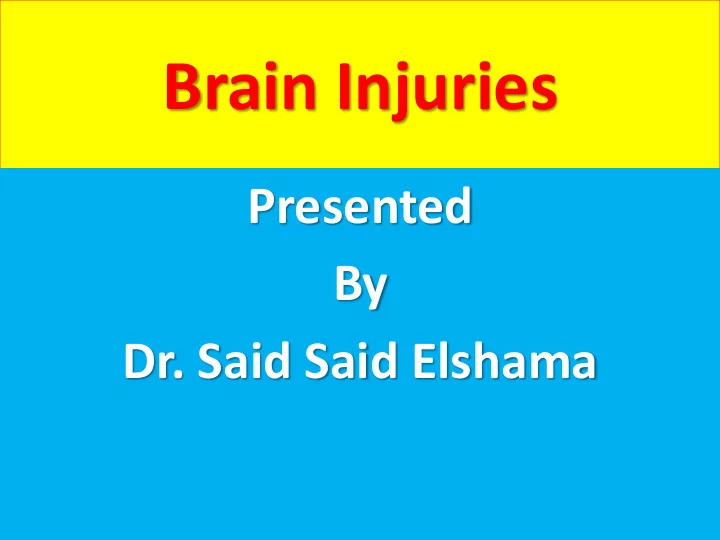

Brain Injuries Presented By Dr. Said Said Elshama
Types of head injuries 1- Scalp injuries 2- Skull injuries 3- Intra – Cranial injuries ( Brain )
Anatomical structure of meninges
Intra- Cranial Injuries (Brain) 1- Concussion 2- Compression :- A- Extra-dural Hemorrhage . B- Subdural Hemorrhage . C- Subarachnoid Hemorrhage . D- Intra-cerebral Hemorrhage . E- Depressed Cranial bone
Concussion • It is a sudden transient loss of consciousness following head injuries. • It is associated with temporary and brief arrest of brain and vital functions. • Simple concussion is not associated with structural damage of brain and followed by complete recovery without residual signs. • It is due to generalized vibratory waves affecting reticular formation which is responsible for the normal conscious state .
Clinical presentation of concussion • loss of consciousness (seconds to minutes). • Loss of reflexes, general muscular flaccidity. • Equal normal pupils or dilated in severe concussion • No signs of lateralization • Weak rapid pulse, shallow rapid respiration, low blood pressure, subnormal temperature and pale face. • Vomiting
Prognosis of concussion 1- Complete recovery. 2- Incomplete recovery (post- concussion “PC”) 3- Concussion passing to compression:- A- With lucid interval (Extra-dural hemorrhage) B- Without lucid interval (depressed bone) Lucid interval - It is a temporary recovery between the loss of consciousness in concussion and in compression.
Medico-legal importance of Lucid interval 1- Patient should be under observation in hospital for 48 hours at least (mal-practice). 2- Patient may mention to the name of assailant . 3- The defense may deny that the cause of head injury such as the blow is the cause of death because the patient recovered after the injury.
Compression - It causes an increase in the intracranial pressure. - It causes cerebral irritation (cerebral congestion)followed by cerebral paralysis (cerebral anemia). - Clinical presentation loss of conscious, vomiting ,papilledema, slow pulse and breathing , high blood pressure and focal neurological signs (lateralization signs) - lateralization signs Unequal pupils, unilateral exaggerated reflexes, unilateral hyper or hypotonic, and unilateral fits
A- Extradural hemorrhage - It is due to trauma by a blow on the side of the head leading to rupture of middle meningeal artery (temporal bone fissure) or venous sinuses . Extradural hemorrhage
B- Subdural hemorrhage 1- Traumatic subdural hemorrhage A- Acute subdural hemorrhage It is due to tearing of the vessels of subdural space related to cranial fracture B- Chronic subdural hemorrhage It is due to minor trauma in alcoholic person leading to successive hemorrhages over months 2- Pathological subdural hemorrhage It is an extension of subarachnoid or intra-cerebral hemorrhage
C- Subarachnoid hemorrhage - It occurs between arachnoid and pia mater. - It is due to pathological cause as the following:- 1- Extension of pathological intra-cerebral hemorrhage 2- Rupture of aneurysm Hemorrhage in subarachnoid space due to rupture of congenital or mycotic aneurysm (bacterial endocarditis)
D- Intra-cerebral hemorrhage 1- Traumatic A- Coup injury Direct relation to the site of trauma B- Contre-coup injury Opposite to the site of trauma 2- Pathological (cerebral apoplexy) Hemorrhage inside the brain substance due to hypertension with diseased arteries(atherosclerosis )
E- Depressed cranial bone - It is a traumatic Coup injury. - Intra-cerebral hemorrhage is in a direct relation to the depressed fracture. - Patient passes directly from concussion to compression.
Diffuse axonal injury (DAI) • It is shearing (tearing) of the brain's long connecting nerve fibers (axons) when the brain is shifted and rotated inside the bony skull. • It causes brain changes that are microscopic and may not be visible on (CT) or (MRI) scan. • It may cause brain injury, rise of intracranial pressure and coma.
Causes of diffuse axonal injury It results from the brain movement in the skull (acceleration or deceleration):- Motor car accidents Sport accidents Violence Falls Child abuse (Shaken Baby Syndrome)
Complications of head injuries 1- Retrograde Amnesia 2- Post-traumatic Automatism 3- Post- traumatic Neurosis 4- Epilepsy 5- Sepsis (brain abscess, meningitis, sinus thrombosis) 6- Permanent Infirmity
Cause of Death 1- Early :- A- Concussion B- Compression C- Cerebral Laceration 2- Delayed :- A- Brain abscess B- Sinus thrombosis C- Meningitis
Thank you
Recommend
More recommend